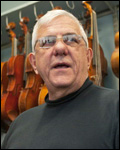When not building violins and cellos, Paul Schuback has amused himself by serving in Portland civic politics, riding his BMW motorcycle, and restoring old cars. His latest love is a 1956 British Land Rover with a factory-original fire engine conversion that he and his son picked up in Ireland.
▪ bio current as of 2001

